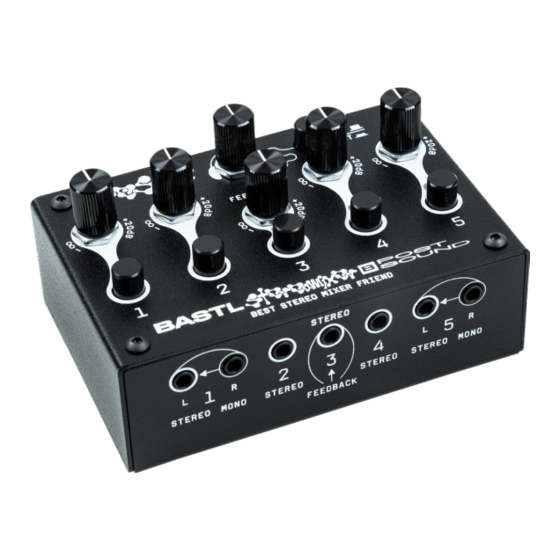
Advertisement
Quick Links
Advertisement

Summary of Contents for Bastl BESTIE
- Page 1 BEST STEREO MIXER FRIEND BASTL INSTRUMENTS...
- Page 2 Bestie Manual Bestie is a 5-channel stereo mixer with up to 20 dB boost, mute switch per channel, and flexible connectivity. However, Bestie is not just a mixer but also a stereo distortion/saturator with a pre-routed feedback channel that can create juicy, crunchy sounds. Mixing with Bestie can be pure vanilla if you keep all the levels left of the 12 o’clock position, but once...
-
Page 3: Technical Details
Features ● 5 stereo channels ● Mute switch with light indication per channel ● Level control per channel with up to 20 dB boost ● Low noise preamps with sweet overdrive character (same as Dude) ● Inputs via 3.5 mm stereo jacks ●... - Page 4 Flip the power switch to the ON position, and the light on the front panel under the name Bestie will light up. Note: USB-C input will take priority over AA batteries. Batteries will not be...
- Page 5 Inputs Inputs 2, 3 and 4 are 3.5 mm stereo jack inputs designed for stereo line- level devices. Channels 1 and 5 have flexible routing options: 1 Connect a mono jack to the R input. It will be normalized to the L input and you can hear the same mono signal in both left and right channels.
- Page 6 However, fascinating outcomes arise when these feedback signals are interrupted by elements such as drums. They interact with the feedback tones and compete for dominance. Bestie is well suited for such experiments and directly encourages you to overload its circuitry and make the signals go ape.
- Page 7 Mute Press the Mute switches to change the mute state of a channel. When the light is on, it means the channel is active, and the light off means it is disabled. You can also slightly press the button to make it temporarily unmuted.
- Page 8 The trimmer, accessible with a small flat screwdriver at the right side of Bestie, is there to gain-match the left and right channels. While mixing, a mismatch usually has little effect because the amplitude tolerances are minimal. But when feedbacking Bestie, it can manifest in audible tonal mismatch and distortion differences.
- Page 9 Some USB devices, such as sound cards or mixers, may have separate USB ground and audio ground. On the other hand, other devices, including Bestie, share the ground between USB and audio. When connecting audio and USB ground, you may create ground loops and introduce noise into your system, especially if one or more of the devices is not suitable for this kind of connection (such as the OP-Z, K-Mix, Motu M4, etc.).
-
Page 10: Setup Examples
If your drum machine has separate outputs, you may want to consider mixing them externally and adding saturation to enhance their sound. The Bestie’s internal feedback channel interacts perfectly with drums. Activate Channel 3 to get more dirt out of your drum machine. - Page 11 Preview different parts on headphones while muted in the MIX OUT: When mixing multiple synth or drum parts, you can use the headphone output with the switch in the PRE mute position to pre-listen to all the channels before unmuting them to the speaker system. DRUM MACHINE...
- Page 12 Stereo saturation is an under-appreciated concept in the hardware domain, as most distortions and saturators are not stereo. For animated distortion sound, use the stereo auto-pan effect before Bestie. Chorus or any other stereo-widening modulated effects will also add subtle yet very elegant complexity.
- Page 13 Stereo feedback loop with an effect: To expand on the feedback channel idea, consider patching the headphones output into a stereo effects box and patching it back to the input. This way, the effect will play a major role in sculpting the feedback tone and behavior.
- Page 14 Most analog mixers lack stereo aux sends. If you would like to use a stereo effect with a stereo source, you might want to use Bestie as a simple stereo mixer to mix your effect. It will also be great for performing because you can use the mute switches to toggle the effects on and off.
-
Page 15: Audio Interface
If you’re preparing for a live performance and require an in-ear monitoring system, but your computer audio interface cannot provide an independent headphone mixdown, you can use Bestie to achieve this. Simply split all channels being sent to the front-of-house mixing engineer and mix them independently using Bestie. - Page 16 Beta Testers David Žáček, Milan Říha, John Dinger, Peter Edwards, Oliver Torr, Patrik Veltruský, Niels Aras, David Herzig, Marco Menzle Management John Dinger Graphic design Anymade Studio The idea turned into reality thanks to everyone at Bastl Instruments and thanks to the immense support of our fans.
- Page 17 www.bastl-instruments.com...





Need help?
Do you have a question about the BESTIE and is the answer not in the manual?
Questions and answers